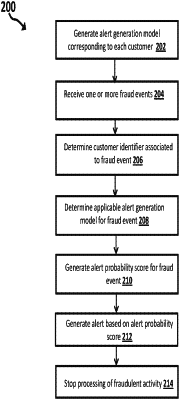| CPC G06Q 30/0185 (2013.01) | 20 Claims |

|
1. A method comprising:
receiving, by a computing system, one or more fraud events comprising one or more fraud indicators associated with a fraudulent activity from one or more fraud detection devices,
wherein each of the one or more fraud detection devices executes one or more fraud detection algorithms to identify data associated with the one or more fraud indicators based on one or more fraud scenarios;
determining, by the computing system, a user identifier associated with each fraud event based on the data associated with the fraudulent activity;
determining, by the computing system, an alert-generation model applicable to each fraud event based on the user identifier associated with each fraud event;
generating, by the computing system, an alert probability score corresponding to each fraud event by executing the determined alert-generation model;
updating, by the computing system, the one or more fraud detection algorithms by modifying the one or more fraud scenarios based on the alert probability score corresponding to each fraud event;
generating, by the computing system, an alert associated with the fraud event upon determining that the alert probability score exceeds a pre-defined threshold score; and
in response to the computing system generating the alert for the fraudulent activity:
generating, by the computing system, one or more instructions to cease execution of a request associated with the fraudulent activity; and
updating, by the computing system, a behavior profile of the user to include a record of the fraud event in the account of the user, whereby the computing system trains the alert-generation model using the updated behavior profile.
|